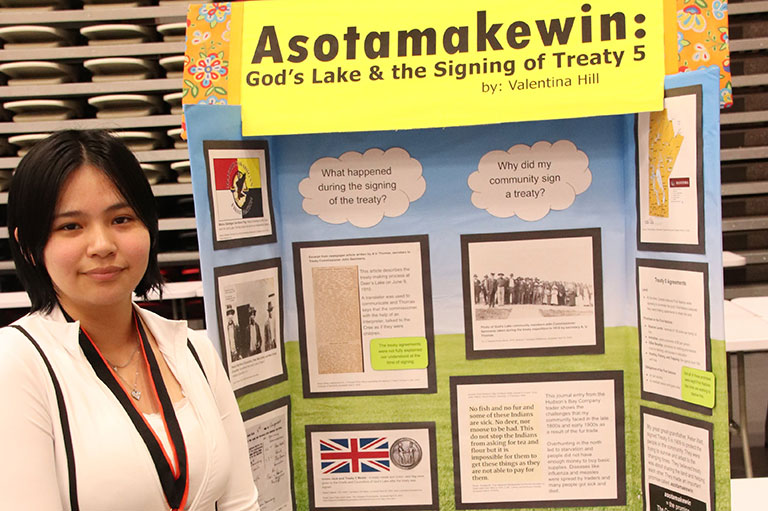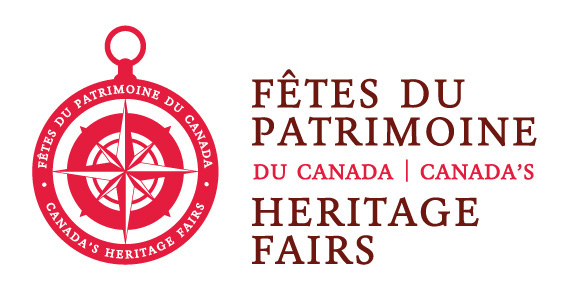Valentina H.

God’s Lake First Nation & the Signing of Treaty 5
Valentina H.
Red River Heritage Fair
Winnipeg, MB
Very soon after starting my project about why the treaty was signed, I realized that I needed to understand how my community was affected by the fur trade. I found out that the Cree people along the Hayes River started taking on important roles in the fur trade in the late 1600s such as the home guard and middleman. As the fur trade declined in the 1800s, many First Nations in northern Manitoba were experiencing hard times due to overhunting, loss of traditional ways, and the spread of disease. I found out that the Treaty Commissioner John Semmens visited my community in 1908 to discuss the treaty and he returned the following year to have it signed. At the treaty signing, Chief Peter Watt and councillors Big Simon and Peter Chubb were given a medal and a British flag was wrapped around them. An interpreter explained in a simple way that the Queen promised to take care of them. From my research and interviews, I realized that the First Nations and the government of Canada had different understandings of what the signing of the treaty meant. My community believed that they were making an agreement to share the land and signing the treaty did not take away their rights as a nation. Most importantly, I began to understand why my great-great grandfather, Peter Watt, signed an adhesion to Treaty 5. It was to protect the people, the land, culture and to create a good future for my community.
What sources and evidence did you consult for your project? What different perspectives did they provide on your topic?
I read many secondary sources including parts of Dr. Stewart Hill’s PhD thesis about water governance in my community and the “Treaty Research Report - Treaty Five (1875)” by Kenneth S. Coates and William R. Morrison. I also searched the Archives of Manitoba for information about the treaty signing. I found a photo album filled with photos of the 1910 trip led by Treaty Commission John Semmens and documented by Alfred Vernon Thomas, a Winnipeg journalist, who acted as a clerk. The album also included clippings of his news articles which described the treaty making process and a visit to my community the year after it was signed. Most importantly, I interviewed various people in my community including Chief Gilbert Andrews, Keith Peskoonas (God’s Lake Land Manager) and Elders including Gordon Andrews, Sarah Hasting, Howard James Okemow and Delia Bee.. Before reading the “Treaty Research Report - Treaty Five (1875)” I thought it was only the Canadian government that wanted to start a treaty relationship, but I learned that some First Nations communities in Manitoba asked the government to start treaty negotiations. Talking to people in my community helped me understand that the treaty was needed because of how hard life was in the past and that the treaty agreements were made between nations. It also helped me realize that treaty is still important today.
What is the historical significance of your topic?
The Cree word describing treaty is Asotamakewin. This means the promise. Signing a treaty was a promise to share the land. But after the treaty was signed, life changed for people in my community. While the people in my community were expecting help from the government, this did not happen. Instead, the government now had more control over the land. They had to follow rules made by the government of Canada and children were sent to Residential Schools. As a result, some people in God’s Lake First Nation experience intergenerational trauma and are currently working to heal and strengthen the community. Many of the promises were not met such as the amount of land or supplies like agricultural tools were not delivered. Many First Nations, including my community, God’s Lake Narrows have continued to ask the government to honour the promises that were made. Treaty is still important today. It’s a living document and way for First Nations and Canadians to live and grow together so the signing of the treaty and the promises made need to be understood by all Canadians.
Why did you choose this topic?
On August 6, 1909, Peter Watt, my great-great-grandfather, the newly elected Chief of God’s Lake First Nation, along with two councilors, Big Simon and Peter Chubb, signed an adhesion to Treaty 5. Signing the treaty would change our lives forever. I wanted to learn more about my community and its past. Before starting the project, I didn’t know a lot about the treaty signing, but I often wondered why it was signed and why we were receiving the $5 annuity payment. Doing this project helped me answer some of these questions and it also created many more.

